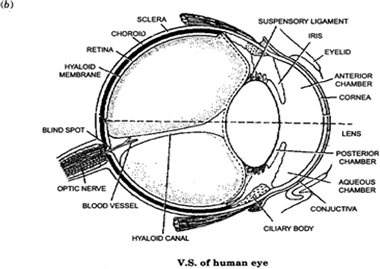 Long Answer Type
Long Answer Type(a) Describe the structure of arteries, veins and capillaries. Explain the way in which each of these is adapted for its function.
(b) Give an account of the ‘Mass Flow Hypothesis’ for translocation of solutes.
(c) Give the meaning of the following:
(i) Digestion (ii) Assimilation
(a) Give a schematic representation of non-cyclic photophosphorylation showing both the photosystem.
(b) Describe the structure of a myofibril of a striated muscle.
(c) Give four points to show the importance of vegetative propagation.
(a) Describe the mechanism of inspiration and expiration in man.
(b) Draw a labelled diagram of the vertical section of the human eye.
(c) (i) What is Ageing?
(ii) Give two functions of the amniotic fluid.
(a)
The process of taking in or drawing fresh air into the lungs and expelling out stale air from the lungs is called breathing. It is a purely mechanical process that is completed in the following two steps:
(i) Inspiration (ii) Expiration
The movement of air in and out of the lungs takes place due to alternate change in the pressure inside the lungs which is caused by the contraction and relaxation of diaphragm and the intercostal muscles.
During inspiration, the intercostal muscles contract that lifts the ribs upwards and outwards. At the same time, diaphragm also contracts and becomes flat by moving down. As a result the volume of the thoracic cavity increases. This reduces the pressure of air in it which in turn causes the fall of pressure in the lungs below the atmospheric pressure. As a result, the atmospheric air rushes into the lungs passing through the respiratory passage and bringing about inspiration. After inspiration, the intercostal muscles and diaphragm are relaxed moving upwards. The volume of the thoracic cavity is reduced which increases pressure inside the lungs above the atmospheric pressure. This forces the air from the lungs to out causing expiration.
In this way, each breathing consists of one inspiration and one expiration. It is an involuntary process which is carried out automatically at a constant rate in a healthy individual.
(i) Ageing: Ageing is the process of progressive deterioration in the structure and function of the cells, tissues and organs of an organism as it grows older.
(ii) Functions of Amniotic fluid are as follows:
1. It acts as a cushion and hence protects the developing foetus from mechanical jerks.
2. It helps in the movement of foetus inside the mother’s womb and also lubricates the birth canal during the child birth.(a)
(i) Draw a labelled diagram of chloroplast as seen under an electron microscope.
(ii) Name the three major photosynthetic pigments.
(b) Describe the events that take place between pollination and fertilisation in plant.
(c) Name the hormones associated with the following :
(i) The only gaseous plant regulator.
(ii) A growth inhibitor in plants.
(iii) Resorption of water from the urine in the distil convoluted tubule.
(iv) Rise in blood calcium.
(a) Explain the DDT resistance of mosquitoes to the pesticide.
(b) What are the symptoms of Diabetes mellitus?
(c) Define :
(i) Gene pool
(ii) Genetic Erosion.
(a) Write short notes on:
(i) DNA finger printing
(ii) Cryopreservation
(iii) Hemophilia
(iv) Green manure.
(b) What are the activities of Community Health Services.
(c) Give the differences between B cells and T cells.
(a) Describe Lederberg’s Replica Plating experiment to show the genetic basis of adaptation.
(b) Give an account of chromosomal aberrations (mutations).
(c) What is a pacemaker?